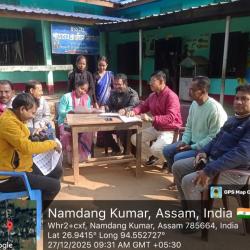"Who said agriculture is a business of loss. I am saving more than Rs 80,000/- (about USD 1,750) every year and providing bread & butter to my 11 family members who are dependent on me," said Prabhavati Devi, who lives in Sardar Nagar block of Gorakhpur district. She has one and half acres land in which she is producing more than 86 types of crops annually. Prabhavati Devi is doing organic farming, which is a very reliable method of sustainable agriculture resulting in high production at low cost.
According to her, '12 years back I too was doing chemical farming and had no idea about this model of sustainable agriculture which involves an efficient management of time and land available for farming.
However, when I came in contact with Gorakhpur Environmental Action Group, GEAG (A Eastern UP based Non-Governmental Organization), I learned how to use indigenous-technical knowledge.' She further said that, 'although my husband and other family members are not supportive of my agriculture work, I have shown them how a woman farmer can make agricultural production a sustainable and financially viable activity.' She is also the head of 'Yamuna Self Help Group' which has now become a Federation having five committees. She is also provides training to other farmers all over India. Thus Pravhavati Devi has become an ideal other women farmers.
According to Dr. Sheema Tripathi, working in GEAG, "sustainable agriculture should not be confused with organic farming as both are very different form each other. Sustainable agriculture means not only the withdrawal of synthetic chemicals, hybrid-genetically modified seeds and heavy agricultural implements, it also tries to simulate the conditions found in nature. Sustainable agriculture involves Multiculture, intercropping, use of farmyard manure and remnants, mulching and application of integrated pest management. If this is followed then there is no reason why agriculture cannot be an economically viable activity in addition to being environmentally sustainable.'
She further said that, 'Sustainable agriculture is very profitable in terms of money and soil conservation in the long run. Without doubt, it can meet the requirements of the country. GEAG tried to study this issue in eastern Uttar Pradesh and found that very few farmers follow the whole set of practices required in sustainable agriculture. However, thousands of farmers across the state use chemical pesticides.'
According to The United Nations Population Fund, (UNFPA) report India is projected to be the most populous country in the world by 2050, overtaking China. Its population, now 118.6 crores, is projected to be 165.8 crores in 2050. Increasing population growth is likely to reduce the area under agriculture. The major thrust of the agricultural development programmes in India is on efficient use of scarce natural resources like land, water and solar- energy. This can be achieved only through improved productivity in a cost-effective manner, which alone would result in the welfare of the farmers and agricultural labor. Balanced and integrated use of fertilizers, agricultural credit, institutional support, accelerated investments in agriculture, enhancing the competitiveness of agro-exports, creation of additional irrigation facilities etc. are being given encouragement through various schemes and activities of the Government of India.
'Most people in rural India depend directly or indirectly on farming for their livelihood.
Despite this, not enough attention has been given to agriculture to overcome poverty. The agriculture sector has a vital place in the economic development of India. However, very little interest has been shown by the policy makers to strengthen sustainable agriculture in India,' said Dr. Shiraj A. Wajih, President of Sustainable Agriculture Network (SANUP), a network of more than 200 NGOs working in agriculture sector in Uttar Pradesh. SANUP is the only network in Uttar Pradesh which is directly working with the farmers to strengthen their knowledge of sustainable agriculture growth. However, it is a matter of concern that even the government, along with the multinational companies, seems to be aggressively promoting chemical farming in order to make quick profits. This is violating the basic norms of sustainable agriculture and will be counter-productive in the long run.' He further said that, 'the biggest and most important achievement of sustainable agriculture network has been in sustainable agriculture literacy in bringing about a change in farmers thinking and perceptions.'
India is a land of agriculture and which needs to be strengthened in a sustain way. The government should make farmer-friendly policies and should encourage farmers to adopt low input cost and high production methods. In this way agriculture will become not only a means of subsistence for the poor but will also become the back-bone of Indian economy.
- Amit Dwivedi
(The author is a Special Correspondent to Citizen News Service (CNS). He can be contacted at: amit@citizen-news.org, website: www.citizen-news.org)
According to her, '12 years back I too was doing chemical farming and had no idea about this model of sustainable agriculture which involves an efficient management of time and land available for farming.
However, when I came in contact with Gorakhpur Environmental Action Group, GEAG (A Eastern UP based Non-Governmental Organization), I learned how to use indigenous-technical knowledge.' She further said that, 'although my husband and other family members are not supportive of my agriculture work, I have shown them how a woman farmer can make agricultural production a sustainable and financially viable activity.' She is also the head of 'Yamuna Self Help Group' which has now become a Federation having five committees. She is also provides training to other farmers all over India. Thus Pravhavati Devi has become an ideal other women farmers.
According to Dr. Sheema Tripathi, working in GEAG, "sustainable agriculture should not be confused with organic farming as both are very different form each other. Sustainable agriculture means not only the withdrawal of synthetic chemicals, hybrid-genetically modified seeds and heavy agricultural implements, it also tries to simulate the conditions found in nature. Sustainable agriculture involves Multiculture, intercropping, use of farmyard manure and remnants, mulching and application of integrated pest management. If this is followed then there is no reason why agriculture cannot be an economically viable activity in addition to being environmentally sustainable.'
She further said that, 'Sustainable agriculture is very profitable in terms of money and soil conservation in the long run. Without doubt, it can meet the requirements of the country. GEAG tried to study this issue in eastern Uttar Pradesh and found that very few farmers follow the whole set of practices required in sustainable agriculture. However, thousands of farmers across the state use chemical pesticides.'
According to The United Nations Population Fund, (UNFPA) report India is projected to be the most populous country in the world by 2050, overtaking China. Its population, now 118.6 crores, is projected to be 165.8 crores in 2050. Increasing population growth is likely to reduce the area under agriculture. The major thrust of the agricultural development programmes in India is on efficient use of scarce natural resources like land, water and solar- energy. This can be achieved only through improved productivity in a cost-effective manner, which alone would result in the welfare of the farmers and agricultural labor. Balanced and integrated use of fertilizers, agricultural credit, institutional support, accelerated investments in agriculture, enhancing the competitiveness of agro-exports, creation of additional irrigation facilities etc. are being given encouragement through various schemes and activities of the Government of India.
'Most people in rural India depend directly or indirectly on farming for their livelihood.
Despite this, not enough attention has been given to agriculture to overcome poverty. The agriculture sector has a vital place in the economic development of India. However, very little interest has been shown by the policy makers to strengthen sustainable agriculture in India,' said Dr. Shiraj A. Wajih, President of Sustainable Agriculture Network (SANUP), a network of more than 200 NGOs working in agriculture sector in Uttar Pradesh. SANUP is the only network in Uttar Pradesh which is directly working with the farmers to strengthen their knowledge of sustainable agriculture growth. However, it is a matter of concern that even the government, along with the multinational companies, seems to be aggressively promoting chemical farming in order to make quick profits. This is violating the basic norms of sustainable agriculture and will be counter-productive in the long run.' He further said that, 'the biggest and most important achievement of sustainable agriculture network has been in sustainable agriculture literacy in bringing about a change in farmers thinking and perceptions.'
India is a land of agriculture and which needs to be strengthened in a sustain way. The government should make farmer-friendly policies and should encourage farmers to adopt low input cost and high production methods. In this way agriculture will become not only a means of subsistence for the poor but will also become the back-bone of Indian economy.
- Amit Dwivedi
(The author is a Special Correspondent to Citizen News Service (CNS). He can be contacted at: amit@citizen-news.org, website: www.citizen-news.org)
- Add new comment
- 50215 reads










Comments
Pages
Add new comment